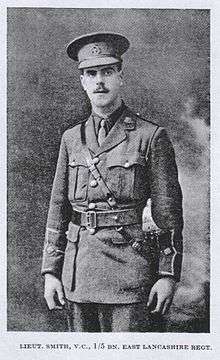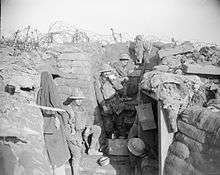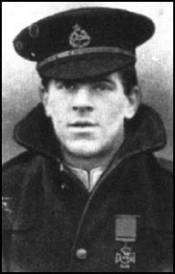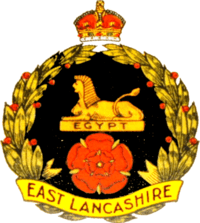East Lancashire Regiment
| East Lancashire Regiment | |
|---|---|
|
Badge of the East Lancashire Regiment | |
| Active | 1 July 1881–1 July 1958 |
| Country |
|
| Branch |
|
| Type | Infantry |
| Role | Line infantry |
| Size |
1–2 Regular battalions |
| Garrison/HQ |
Burnley Barracks (1881 – 1898) Fulwood Barracks, Preston (1898 – 1958) |
| Motto(s) | Spectamur agendo (judge us by our deeds) |
| Colors | White facings |
| Engagements | Second Boer War, Western Front (World War I), Battle of Dunkirk, Burma Campaign |
The East Lancashire Regiment was, from 1881 to 1958, a line infantry regiment of the British Army. The regiment was formed in 1881 under the Childers Reforms by the amalgamation of the 30th (Cambridgeshire) Regiment of Foot and 59th (2nd Nottinghamshire) Regiment of Foot with the militia and rifle volunteer units of eastern Lancashire.[1] In 1958 the regiment was amalgamated with the South Lancashire Regiment to form the Lancashire Regiment which was, in 1970, merged with the Loyal Regiment (North Lancashire) to form the Queen's Lancashire Regiment. However, in 2006, the Queen's Lancashire were amalgamated with the King's Own Royal Border Regiment and the King's Regiment (Liverpool and Manchester) to form the present Duke of Lancaster's Regiment (King's, Lancashire and Border).
History
Formation and service to 1914
Regular battalions

The 1st Battalion was formed from the 30th (Cambridgeshire) Regiment of Foot (raised in 1702) and the 2nd Battalion from the 59th (2nd Nottinghamshire) Regiment of Foot (raised 1755) and the regiment was renamed the East Lancashire Regiment in July 1881.[2]
Under the system introduced in 1881, one battalion of each infantry regiment was to serve at a home station while the other was in a foreign garrison or on active service. Due to the emergency caused by the outbreak of war in South Africa in 1899 most home service battalions were dispatched to the conflict.[1] The 1st East Lancashire Regiment arrived at Cape Town in early February 1900.[3]
| 1st Battalion | 2nd Battalion | ||
|---|---|---|---|
| Location | Years | Location | Years |
| India (Took part in the Chitral Expedition of 1895) |
1881 – 1897 | England | 1881 – 1883 |
| Ireland | 1883 – 1893 | ||
| Gibraltar | 1893 – 1895 | ||
| England | 1895 – 1897 | ||
| England and Jersey | 1897 – 1900 | India | 1897 – 1911 |
| South Africa (Second Boer War) |
1900 – 1902 | ||
| Ireland | 1905 – 1908 | ||
| England | 1908 – 1914 | South Africa | 1911 – 1914 |
Militia and volunteer/territorial battalions
The 1881 reforms also linked the militia and rifle volunteer units of the area into the regimental structure:
- The 5th Royal Lancashire Militia was redesignated as the 3rd (Militia) Battalion of the East Lancashire Regiment.[1]
- The 2nd Lancashire Rifle Volunteer Corps, based at Blackburn: renamed to 1st Volunteer Battalion, East Lancashire Regiment in 1889[1]
- The 3rd Lancashire Rifle Volunteer Corps, based at Burnley: renamed to 2nd Volunteer Battalion, East Lancashire Regiment in 1889[1]
The militia was a reserve force that was only liable to service in the United Kingdom and in peace time assembled for period of annual training. In time of war it could be "embodied" or mobilised. When the war that broke out in South Africa in 1899 began to absorb a large amount of the regular army's resources, the terms of service of the militia were altered to allow them to serve in the war. The 3rd Battalion was embodied in January 1900 and served in South Africa until 1902. It was disembodied in March 1902. The battalion was awarded the battle honour "South Africa 1900–1902".[4]
The volunteer battalions were organised for home defence purposes, and their members were subject to regular drills and training. Like the militia battalion, elements of the volunteers fought in South Africa. While members of the Volunteer Force could not be required to serve overseas, members from the battalions were voluntarily formed into Active Service Companies, providing reinforcements for the regular battalion. Both volunteer battalions were awarded battle honours for the war.[5][6]
1908 reorganisation
In 1908, under the Territorial and Reserve Forces Act 1907 the militia and volunteer force were reconstituted as the "Special Reserve" and "Territorial Force" (TF). Territorial battalions were renumbered in series after the special reserve battalions. The resulting titles were:
- 3rd (Special Reserve) Battalion
- 4th Battalion (TF) (formerly 1st Volunteer Battalion)
- 5th Battalion (TF) (formerly 2nd Volunteer Battalion)
The Territorial Force was restructured into 14 infantry divisions, and the 4th and 5th battalions formed part of the East Lancashire Brigade of the East Lancashire Division. It was as part of that division that were to be mobilised in August 1914 after the outbreak of World War I.[5]
First World War

The size of the regiment was increased during the conflict, reaching a total of 17 battalions.[7]

| Battalion | Notes | Service |
|---|---|---|
| 1st | Regular battalion | Western Front August 1914–1918 |
| 2nd | Regular battalion | in South Africa at outbreak of war, Western Front November 1914 – 1918 |
| 3rd | Special Reserve | Embodied at Preston August 1914, served in home stations at Plymouth and Marske by the Sea |
| 1/4th | Redesignation of 4th (TF) Battalion on formation of duplicate 2/4th in September 1914 | Egypt September 1914, Gallipoli 1915, Egypt 1916, Western Front 1917 - 1918. Redesignated as 4th Battalion in 1918 |
| 2/4th | Duplicate of 4th Battalion formed September 1914 | Home service until March 1917, Western Front March 1917 – February 1918, when it was absorbed by 1/4th. |
| 3/4th | Formed March 1915 as duplicate of 1/4th | Depot and training unit remained in UK |
| 1/5th | Redesignation of 5th (TF) Battalion on formation of duplicate 2/5th in September 1914 | Egypt September 1914, Gallipoli 1915, Egypt 1916, Western Front 1917 - 1918. |
| 2/5th | Duplicate of 5th Battalion formed September 1914 | Home service until March 1917, Western Front March 1917 – 1918. Disbanded July 1918. |
| 3/5th | Formed March 1915 as duplicate of 1/5th | Depot and training unit remained in UK. |
| 6th | Service battalion formed August 1914. | Gallipoli July 1915, Egypt January 1916, Mesopotamia February 1916 – 1918 |
| 7th | Service battalion formed September 1914 | Western Front 1915 – 1918. Disbanded February 1918. |
| 8th | Service battalion formed September 1914 | Western Front 1915 – 1918. Disbanded February 1918., officers and men transferred to 11th Battalion |
| 9th | Service battalion formed September 1914 | Western Front September – November 1915. Salonika November 1915 – 1918. |
| 10th | Service battalion formed October 1914 | Home Service. Converted to reserve battalion 1915, redesignated 47th Training Reserve Battalion 1916 and ceased to be part of the regiment. |
| 11th | "Accrington Pals": Service battalion formed September 1914 by mayor and corporation of Accrington | Egypt December 1915 – March 1916, Western Front March 1916 – 1918 |
| 12th | Reserve battalion of the Accrington Pals formed May 1915 | Redesignated 75th Training Reserve Battalion 1916 and ceased to be part of the regiment. |
| 13th | Redesignation of 8th Garrison Guard Battalion July 1918. | Western Front |
Victoria Crosses

Four members of the regiment were awarded the Victoria Cross for gallantry:
- Drummer Spencer John Bent, 1st Battalion (Le Gheer, Belgium, 1 –2 November 1914)
- Private William Young, 8th Battalion (Fonquevillers, France, 22 December 1915)
- Second Lieutenant Alfred Victor Smith, 1/5th Battalion (Helles, Galliopoli, Turkey, 23 December 1915)
- Second Lieutenant Basil Arthur Horsfall, attached to 11th Battalion (Between Moyenneville and Ablainzevelle, France, 21 March 1918)
Inter war
Between the Wars the East Lancs served in many conflicts including Baluchistan, Afghanistan, Ireland, Turkey, Palestine and the North West Frontier of India.[8]
| 1st Battalion | 2nd Battalion | ||
|---|---|---|---|
| Location | Years | Location | Years |
| West Indies | 1919–22 | Ireland | 1919–1923 |
| Malta | 1922–1923 | ||
| Egypt | 1923–1924 | England | 1923–1933 |
| India | 1924–1931 | ||
| China | 1932–1933 | ||
| England | 1933–1934 | Hong Kong | 1933–1937 |
| Saarland | 1934–1935 | ||
| England | 1935–1936 | ||
| Northern Ireland | 1936–1939 | ||
| India | 1937–1939 | ||
Second World War
The East Lancashire Regiment was again increased in size for the duration of the Second World War, although not to such an extent as in 1914–1918. Firstly, prior to the outbreak of hostilities in 1939, the entire Territorial Army was doubled in size, with each unit forming a duplicate. Secondly, a number of wartime battalions were formed.[1]
| Battalion | Notes | Service |
|---|---|---|
| 1st | Regular battalion | The 1st Battalion served in France in 1940 with the 126th Infantry Brigade attached to the 42nd (East Lancashire) Infantry Division. The battalion fought in the Battle of Dunkirk and had to be evacuated to the UK. During the retreat to Dunkirk Captain Andrews was awarded the Victoria Cross. 1944 with 71st Infantry Brigade, transferred to 158th Infantry Brigade, 53rd (Welsh) Infantry Division – 1945 |
| 2nd | Regular battalion | In British India at outbreak of war. To United Kingdom in 1940. South Africa, Madagascar and East Africa 1942 with 29th Independent Infantry Brigade Group –1943, India and Burma 1943 – 1945 |
| 4th | 1st Line Territorial battalion. Formed 1939 when 4th/5th Battalion was duplicated. | North West Europe 1940 with 127th Infantry Brigade, 42nd (East Lancashire) Infantry Division. Following the Dunkirk evacuation, it remained with the division on home defense duties. For most of 1942, the battalion was deployed to Northern Ireland. It then returned to the United Kingdom, and home defense duties, as part of the 76th Infantry Division. In 1944, the battalion became a training formation and was initially posted to the 80th Infantry (Reserve) Division, and finally the 38th Infantry (Reserve) Division. |
| 5th | 2nd Line Territorial battalion. Formed 1939 when 4th/5th Battalion was duplicated. | North West Europe 1944–1945. Formed part of 197th Brigade (with the 1/7th Royal Warwicks and the 2/5th Lancashire Fusiliers), 59th (Staffordshire) Infantry Division during its few months in action following the D-Day landings in the area of Galmanche near Epron during Operation Charnwood. Disbanded August 1944 due to manpower shortage |
| 6th | Home Defence battalion formed August 1939. | Renumbered 30th Battalion 1941. |
| 7th | Raised 1940, transferred to Royal Artillery and converted to 103rd Light Anti-Aircraft Regiment, Royal Artillery December 1941, served with 55th (West Lancashire) Infantry Division, 61st Infantry Division, disbanded March 1944. | |
| 8th | Raised 1940 from 50th (Holding) Battalion, converted to 144th Regiment Royal Armoured Corps in 1941 and served in 33rd Armoured Brigade in the Normandy landings on 6 June 1944. The regiment continued to wear its East Lancashire cap badge on the black beret of the RAC.[9] On 1 March 1945 144 RAC was redesignated 4th Royal Tank Regiment to replace the original 4th RTR, which had been lost at Tobruk in 1942.[10][11][12] | |
| 30th (renumbered from 6th Battalion 1941) | Home Defence battalion | Disbanded 1943 |
| 50th | Holding battalion | Formed from the East Lancashire company of a Mixed Holding battalion at Huyton; brought to full war establishment by a draft of men returned from the Dunkirk evacuation and renumbered 8th 1940.[13] |
Victoria Cross
Captain Harold Marcus Ervine-Andrews of the 1st Battalion was awarded the Victoria Cross for gallantry at Dunkirk on 31 May – 1 June 1940.[14]
Post war
In 1948 the regiment was reduced to a single regular battalion. They served in the Middle East, Malaya, the Suez Canal Zone, and Aden.[15]
In 1957 defence cuts were announced that significantly reduced the size of the army. As a result, the East Lancashire Regiment was amalgamated with The South Lancashire Regiment on 1 July 1958 to form The Lancashire Regiment (Prince of Wales's Volunteers). In 1970 the Lancashire Regiment was in turn amalgamated with the Loyal Regiment (North Lancashire) to form the Queen's Lancashire Regiment.[16] In 2006 the Queen's Lancashire Regiment was merged with the King's Own Royal Border Regiment and King's Regiment (Liverpool and Manchester) to form a new large regiment, the Duke of Lancaster's Regiment (King's, Lancashire and Border).[17]
Badges
When the two regiments of foot merged in 1881, new badges were designed that would endure for the rest of the regiment's existence, subject to changes in the style of crown, and which would be worn on the later service dress and battle dress uniforms. The headdress badge selected for the centre of the full dress helmet was a sphinx upon a plinth inscribed "EGYPT".[18] The sphinx had been awarded to the 30th Foot in 1802 to mark its participation in repelling the French invasion of Egypt[19] The collar badge selected was the Red Rose of Lancaster to mark the regiment's county affiliation.[20] In 1897 a khaki uniform featuring a slouch hat was introduced, and a metal cap badge was devised for each regiment or corps. The badge of the East Lancs was the sphinx and "Egypt" above the rose, the whole enclosed within a laurel wreath topped by a crown. The laurel wreath had formed part of the insignia of the 59th Foot. A scroll inscribed "EAST LANCASHIRE" at the base of the badge completed the design.[18]
Battle honours
The regiment was awarded the following battle honours (those selected for display on the colour are indicated in bold):[1]
- Earlier wars:
- Gibraltar 1704-05, Belle isle, Chitral, South Africa 1900-02
- First World War:[21]
- Le Cateau, Retreat from Mons, Marne 1914, Aisne 1914, '18, Armentières 1914, Neuve Chapelle, Ypres 1915, '17, '18, St Julien, Frezenberg, Bellewaarde, Aubers, Somme 1916, '18, Albert 1916, '18, Bazentin, Pozières, Le Transloy, Ancre 1916, '18, Arras 1917, '18, Scarpe 1917, '18, Arleux, Oppy, Messines 1917, Pilckem, Langemarck 1917, Polygon Wood, Broodseinde, Poelcapelle, Passchendaele, St Quentin, Bapaume 1918, Rosières, Villers Bretonneux, Lys, Estaires, Hazebrouck, Bailleul, Kemmel, Hindenburg Line, Canal du Nord, Cambrai 1918, Selle, Valenciennes, Sambre, France and Flanders 1914–18, Kosturino, Doiran 1917, '18, Macedonia 1915–18, Helles, Krithia, Suvla, Sari Bair, Gallipoli 1915, Rumani, Egypt 1915–17, Tigris 1916, Kut al Amara 1917, Baghdad, Mesopotamia 1916–17
- Second World War:[22]
- Defence of Escaut, Dunkirk 1940, Caen, Falaise, Nederrijn, Lower Maas, Ourthe, Rhineland, Reichswald, Weeze, Rhine, Ibbenburen, Aller, North-West Europe 1940 '44-45, Madagascar, North Arakan, Pinwe, Burma 1944-45
Regimental Colonels
Colonels of the regiment were:[1]
- 1881–1889?: (1st Battalion): Gen. Sir George Vaughan Maxwell, KCB (ex 30th Foot)
- 1881–1889: (2nd Battalion): Gen. Henry Eyre (ex 59th Foot)
- 1889–1890: Gen. Sir Edmund Augustus Whitmore, KCB
- 1890–1913: Lt-Gen. Thomas Henry Pakenham, CB
- 1913–1920: Lt-Gen. Sir Percy Henry Noel Lake, KCB, KCMG
- 1920–1932: Maj-Gen. Sir Cecil Lothian Nicholson, KCB, CMG
- 1932–1944: F.M. Sir John Greer Dill, GCB, CMG, DSO
- 1944–1946: Maj-Gen. Hugh Tennent MacMullen, CB, CBE, MC
- 1946–1956: Brig. James Willie Pendlebury, DSO, MC
- 1956–1958: Maj-Gen. William Harold Lambert, CB, CBE (to Lancashire Regiment)
- 1958: Regiment amalgamated with The South Lancashire Regiment (Prince of Wales's Volunteers) to form The Lancashire Regiment (Prince of Wales's Volunteers)
References
- 1 2 3 4 5 6 7 8 "The East Lancashire Regiment". Regiments.org. 15 July 2000. Archived from the original on 18 January 2008. Retrieved 5 October 2009.
- ↑ "No. 24992". The London Gazette. 1 July 1881. pp. 3300–3301.
- ↑ "Latest intelligence - The War - Movements of Transport". The Times (36058). London. 6 February 1900. p. 5.
- ↑ "5th Royal Lancashire Militia". Regiments.org. 15 July 2000. Archived from the original on 22 November 2007. Retrieved 6 October 2009.
- 1 2 "4th Battalion, East Lancashire Regiment". Regiments.org. 15 July 2000. Archived from the original on 22 November 2007. Retrieved 6 October 2009.
- ↑ "5th Battalion, East Lancashire Regiment". Regiments.org. 15 July 2000. Archived from the original on 22 November 2007. Retrieved 6 October 2009.
- ↑ Chris Baker. "The East Lancashire Regiment in 1914 – 1918". The Long, Long Trail The British Army of 1914-1918. Retrieved 2009-10-04.
- ↑ "Army Reorganisation 1873 & 1881". Lancashire Infantry Museum. Retrieved 31 December 2015.
- ↑ George Forty (1998), "British Army Handbook 1939–1945", Stoud: Sutton Publishing, pp. 50–1, 345.
- ↑ "4th Royal Tank Regiment: Service". Archived from the original on 19 May 2006. Retrieved 31 December 2015.
- ↑ "British Light Infantry Regiments & National Service". Retrieved 31 December 2015.
- ↑
- Alan Jolly, Blue Flash: The Story of an Armoured Regiment, London 1952, p. 2.
- ↑
- Alan Jolly, Blue Flash: The Story of an Armoured Regiment, London 1952, p. 1.
- ↑ "East Lancashire Regiment". Find a Grave. Retrieved October 31, 2011.
- ↑ Downham, John. "The Regiments Post-War". Lancashire Infantry Museum. Retrieved 31 December 2015.
- ↑ "A Short History of The Queen's Lancashire Regiment".
- ↑ "Duke of Lancaster's Regiment". Retrieved 26 April 2014.
- 1 2 Kipling, Arthur L; King, Hugh L (2006). Head-Dress Badges of the British Army: Volume One - Up to the Great War. Uckfield: Naval and Military Press. pp. 152, 186–187. ISBN 1-84342-512-2.
- ↑ Sumner, Ian (2001). British Colours & Standards 1747 – 1881 (2) Infantry. Oxford: Osprey. p. 9. ISBN 1-84176-201-6.
- ↑ Churchill, Colin (2002). History of the British Army Infantry Collar Badge. Uckfield: Naval and Military Press. ISBN 978-1-84342-357-7.
- ↑ "Battle Honours. County Regiments". The Times. 13 April 1924. p. 9.
- ↑ "Battle Honours. Fourteen Regiments Named in New List". The Times. 11 March 1957. p. 7.
External links
| Wikimedia Commons has media related to East Lancashire Regiment. |
